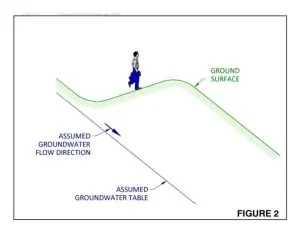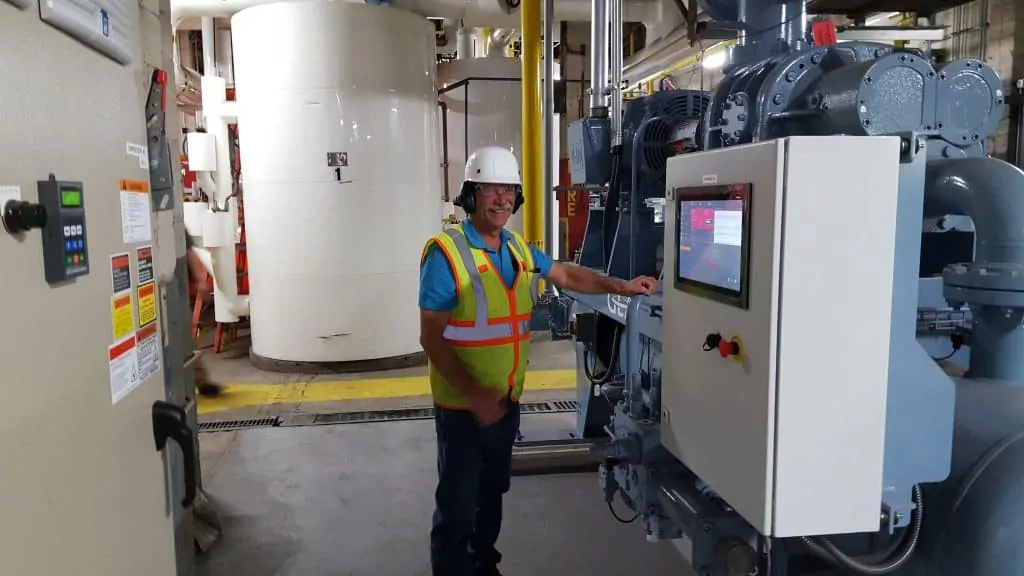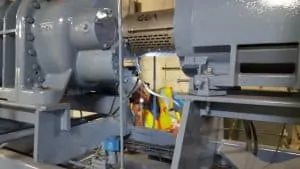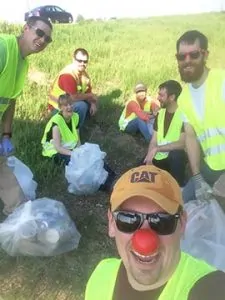

One of the biggest challenges our industry faces is how to provide services with fewer resources. Our latest blog series Doing More With Less shares best practices and strategies that are working in the solid waste industry.
The latest statistical data from the City of Clearwater, Florida shows a 21% decrease in solid waste generation and an annual savings of $107,000 in tipping fees. Operational savings for the City achieved the projected $400,000 savings as forecasted in the SCS rate study.
Learn how Clearwater is doing more with less.
Many environmental projects assume an unconfined aquifer groundwater gradient with a simple arrow and without performing an analysis of the validity of the underlying data and conclusions. Therefore it’s no surprise when deficiencies begin to occur in the project’s outcome.
Your client wants a commercial building installed. The construction seems straightforward, so a quick geotechnical investigation is conducted. The underlying shale is deemed dry after a brief period of well observations did not indicate groundwater was present.
Months later, groundwater problems start to manifest. Seepage at the foundation margins begins occurring. Uplift cracks develop as increasing groundwater pressure is exerted. From where is the groundwater coming; after all, your geotechnical investigation showed the underlying geology was dry.
It turns out that insufficient time was allowed to observe groundwater behavior in the shale. The groundwater was there all the time, but it moves so slowly through the shale that it did not have time to move into the wells that were constructed to check for groundwater. If the wells were left for a longer period—or some other means of checking for groundwater was employed—then the building foundation could have been more adequately designed for the groundwater conditions.
Groundwater gradient is like the sun rising: it’s always assumed and often does not get any real scrutiny in a typical project. However, there are several common scenarios in which basic assumptions about groundwater gradient and the velocity may lead to project design and outcome flaws such as unexpected uplift forces.
Groundwater Gradient and Topography
Groundwater gradient is assumed to be a subdued model of topography. How many times have you heard that? This assumption appears in the majority of environmental project site assessments. However, which topography is referenced? What scale is assumed?
The series of figures here show the problem with assuming gradient is directly tied to topography.
In Figure 1, the ground slope clearly implies a direction of flow—right? That implied direction of flow is illustrated.

Will adding a new, presumed flow direction correct the issue? Not always.
Figure 3 steps back further and shows another topographic reversal and reversed groundwater flow direction. The point is, topography may by no means be a reliable indicator of groundwater flow—it depends on scale. Although the topographic reversals illustrated in Figure 3 seem uncommon, they are vertically exaggerated illustrating that topographic reversals at various scales are the norm.
Groundwater Gradient in Low-Permeability Formations
Groundwater gradient in low permeability formations can be quite deceiving. Erroneous assumptions can be caused by (1) a misunderstanding regarding the hydraulic connectedness between points used to develop a presumed water surface, and (2) extremely slow hydraulic response in a measurement point [well], which may cause water level measurements that are not in equilibrium with the formation water pressure. Let’s explore each of these two items:
Are your groundwater measuring points hydraulically connected? This is often a prima facie assumption that goes without any scrutiny in a site analysis. Water table elevation lines are smoothly drawn between measurements points [wells], implying that any hypothetical well that may be installed in between will indicate a water level consistent with the interpolation. The assumption is certainly valid in textbook illustrations, but the reality of low or varying hydraulic conductivity could create water table variations that differ widely from a simple interpolation between measurement points. It is even possible that a formation is dry between measurement points (see below).
An extremely slow hydraulic response may result in erroneous (premature) interpretations of water level/water pressure in a formation. A well installed in shale may require months or even years to indicate a water level that is in equilibrium with the formation. Consequently, a well reportedly installed in dry shale may not be dry at all—the shale may have considerable pore pressure that just requires substantial time to manifest itself in a well. One solution to this problem if these data must be obtained quickly is to substitute an instant-reading pore pressure transducer instead of a well.
Groundwater Gradient in Urban Environments

Another often-neglected aspect of the urban environment is the effect of paving. Many urban areas feature vast paved areas that prevent groundwater recharge and cause a recharge shadow that may result in an inward gradient that is in most cases distinctly different from what little topographic gradient may exist after construction.
Urban groundwater movement is often more affected by subsurface (i.e., invisible) non-topographic, anthropomorphic features. Features such as leaking pipelines and tanks may cause hidden recharge that affects gradient. Construction activities also often result in preferred pathways or conduits for groundwater flow. Again, most of these artificial subsurface flow conduits are usually hidden. The result is a complex flow regime that does anything but mimic topography.
The Role of Groundwater Velocity
Groundwater velocity is similarly neglected in many project considerations. Assuming groundwater gradient is known accurately, is it important? If the gradient is very flat, the velocity may be insignificant. A flat gradient may be prone to shifting directions, subtly driving a flow gradient in various directions. Project assumptions often include an explicit reference to upgradient and downgradient that may be misleading because the degree or relative flatness and corresponding low velocity may dictate that upgradient vs. downgradient is poorly defined. In this situation, conclusions should not be hastily drawn regarding the apparent impacts of a source that is apparently upgradient.
Best Practices in the Face of Groundwater Gradient, Flow and Velocity Uncertainty
First, acknowledge the uncertainty and address it in your project. Don’t instantly dismiss gradient with a wave of the hand and a simple statement about gradient mimicking topography.
When groundwater gradient is critical to a project design or outcome, it should be directly and carefully measured. Wells or piezometers have to be carefully designed, installed, and surveyed for elevation. Water level measurements must similarly be done with appropriate consideration of the factors noted above.
If you are working in a low-permeability formation, consider the outcome if your measuring points are not hydraulically connected, and therefore cannot be used to map an apparent water surface. If your measuring points are implying a continuous water surface and connected flow regime that does not exist, consider this potential on your project design and outcome.
About Jim Lawrence
Mr. Lawrence is a hydrogeologist with 30 years of expertise in all aspects of hydrogeology and geology. Mr. Lawrence leads the SCS Engineers – Texas solid waste landfill groundwater monitoring programs for clients. He works to resolve problems that arise with groundwater monitoring, including assessment monitoring, corrective action, landfill gas, and alternate source demonstration issues. He is responsible for supervising the sampling, data reporting, and statistical analysis for numerous municipal solid waste landfills and clients in other industries. His job experience includes extensive permitting-related hydrogeologic characterizations of project sites.
In November 2017, SCS Engineers’ John Jones made an unexpected discovery while working at the Okeechobee Landfill owned by Waste Management; he found an injured American bald eagle. With the help of friends from Arnold’s Wildlife Rehabilitation Center (AWRC), the young eagle was rescued and started recovering at AWRC’s facility. No one knows how the eagle was injured, but several staff members had observed three eagles earlier that morning engaging in what appeared to be territorial combat. The staff at AWRC decided to name the bird “JJ” after his rescuer, who, as you can imagine, was delighted. JJ grew and was transported to the Treasure Coast Wildlife Center for continued treatment and rehabilitation culminating with exercise conditioning in a flight cage.
On Saturday, May 27, community residents, staff from Waste Management and SCS Engineers, along with other bird lovers and the media gathered to release JJ back into the wild and to raise funds for local wildlife centers. JJ was released at Waste Management’s certified wildlife habitat at Okeechobee Landfill, which dedicates 2,000 of its 4,100 acres as a habitat certified by the National Wildlife Habitat Council. All proceeds from Saturday’s eagle release event, dubbed “Flight Back to Freedom”, were donated to Arnold’s Wildlife Rehabilitation Center and the Treasure Coast Wildlife Center.

Event attendees said it was inspiring to see JJ take flight. They watched until he disappeared into a distant tree line. “The event was fantastic!” stated Myles Clewner of SCS. “John gave a rousing speech, Waste Management sponsored a fun event, we raised money for two wonderful organizations, and JJ promptly took flight after the cage was opened.”
SCS Engineers presents a behind-the-scenes look at the special people who make us thrive and the roles they play within the organization.

Gene Dumas joined SCS Engineers in 2015 as a Project Manager for the Risk Management
group with a thirty-year background in the ammonia refrigeration business. When asked what attracted Gene to SCS, he said “What SCS Tracer did is what I’ve always wanted to do. SCS Tracer has the passion for making the ammonia industry safer. SCS goes out of the way for customer service. Ammonia refrigeration is a very dangerous industry and what separates SCS from other companies is the commitment to safety.” For years, Gene has known Lee Pyle, Vice President and Project Director for SCS Engineers, within the ammonia refrigeration field and when he met her team at SCS, “I was blown away with their intelligence and passion. They are super smart and a good group. Lee put together a hell of a team.” Considering all those factors, it was an easy decision to join SCS Engineers.
Outside of SCS, Gene has been a member of the Refrigerating Engineers & Technicians Association (RETA) since 2004. RETA is a refrigeration organization with a mission statement to enhance the professional development of refrigerating engineers and technicians. Gene states “it’s basically the education sector of industrial ammonia refrigeration. We train, develop and certify the people who are actually working in the facilities operating systems.”
Eleven years after becoming a member, Gene was sworn in as a national president on October 1st, 2015 and was president for the 2016 year. Presently, he is a chairman for RETA and on his last year on the RETA National Board of Directors.
At SCS, Gene considers one of his greatest achievements is mentoring the newer generation to understand their industry better. “I think my mission in life is to mentor. Mentoring the younger people that are coming in, putting them under my wing, it’s very rewarding, intrinsically rewarding.” Gene comments, “I want to pass my knowledge to the next generation because we’re losing our skilled craftsman. It’s very critical that we train. A trained operator is #1: safe and we need more of them.”
For current and future SCS employees, Gene offers this piece of advice: “I came here because I wanted new challenges and wanted something new every day. The minute you 
SCS Engineers is currently looking for a Senior Professional to add to our Risk Management Ammonia Refrigeration team. For more details visit the SCS Engineers Careers Page or click here to apply directly.
San Diego County is in the midst of an affordable housing shortage — and more units could be lost as government-aided housing agreements expire over time. And the state of California isn’t fairing much better based on a report released by the California Housing Partnership Corporation. BRIDGE Housing, a firm formed in 1983 to address the affordable housing shortage, is doing their part to fill the gap.
One of their recent developments, COMM22, is a mixed-use, mixed income, transit-oriented development located at Commercial and 22nd streets. The development combines much-needed affordable family and senior rental housing with day care facilities, commercial and retail space, affordable townhomes that are currently under development, and future market-rate flats.
Staff from the SCS Engineers Madison, WI office support the Wisconsin Department of Transportation’s Adopt-A-Highway anti-litter program. SCS-Madison adopted a 2-mile section of the Beltline Highway: one of the city’s busiest roads, collecting litter several times during the year to help keep Wisconsin roadsides beautiful.

Financial analysis is an increasingly important issue in solid waste decision making. In an era where the mantra of “doing more with less” is on the lips of most political decision-makers, it is critical to assess the financial performance of operating and proposed solid waste programs. The three issues discussed in this article provide some guidelines on how these kinds of assessments can be conducted.
A variety of CCB/CCP related topics guaranteed to enhance your knowledge. Click the title to read or share these papers.
Jeff Marshall – Mitigating Hydrogen Sulfide Issues at Coal Combustion Residuals and Municipal Solid Waste Co-disposal Sites – Learn about the biological, chemical and physical conditions necessary for FGD decomposition and hydrogen sulfide generation. Marshall will explore technologies that remove and treat hydrogen sulfide from landfill gas and present recommendations for reducing the potential for FGD decomposition at co-disposal facilities.


Oil and gas processing facilities, federal and local governments, landfills, land developers, contractors, industries with industrial hygiene plans can spend too much money for too little information if they don’t have an understanding of the limits and capabilities of their equipment and methods before the development of their Air Monitoring Plan (AMP) . That’s before considering the risk to their employees and to public health.
Even if you can’t afford a dedicated air monitoring group, you can eliminate the health risks, overwriting a plan, or overburdening your budget. A cost-benefit analysis and integrating stakeholders’ goals can help provide the guidance you need to develop a balanced air monitoring plan.
Start with this list of considerations when developing an Air Monitoring Plan (AMP). The list is followed by tips and suggestions which are helpful under specific circumstances.
Location of the monitoring site is initially dependent on the monitoring objective. For example, once it is known that there is a requirement to monitor for peak ambient H2S at a microscale site, it reduces the monitoring site location to specific areas. Hence, the first task when evaluating a possible site location is to determine the scale for which a candidate location can qualify by considering the following:
1. Location and emissions strengths of nearby sources, especially major source;
2. Prevailing wind direction in the area;
3. Nearby uniformity of land use;
4. Nearby population density.
To select locations according to these criteria, it is necessary to have detailed information on the location of emission sources, the geographical variability of ambient pollutant concentrations, meteorological conditions, and population density. Therefore, selection of the number, locations, and types of sampling stations is a complex process. The variability of sources and their intensities of emissions, terrains, meteorological conditions and demographic features require that each network is developed individually. Thus, selection of the network will be based on the best available evidence and on the experience of the decision team.
Developing an Air Monitoring Plan (AMP) can be a daunting task. There are many decisions to make that have downwind ramifications relative to budget, logistical constraints, and labor requirements. In addition, there may be competing goals in regards to the project stakeholders. SCS has the experience developing and implementing air monitoring plans and systems to meet these challenges; including developing site specific and network-wide AMPs for various monitoring objectives. SCS also understands the costs and demands of the implementation of AMPs on industry and government.
If you need to perform Air Monitoring or are in the initial steps of developing an AMP please contact for expert advice and guidance specific to your region and industry. We have robust programs and experts nationwide. We can also incorporate the use of remote monitoring controls and monitoring by our FCC authorized drones.
Author: Paul Schafer, SCS’ National Expert Ambient Air Monitoring

Thank you for your friendship, your business, and the opportunity to serve you.